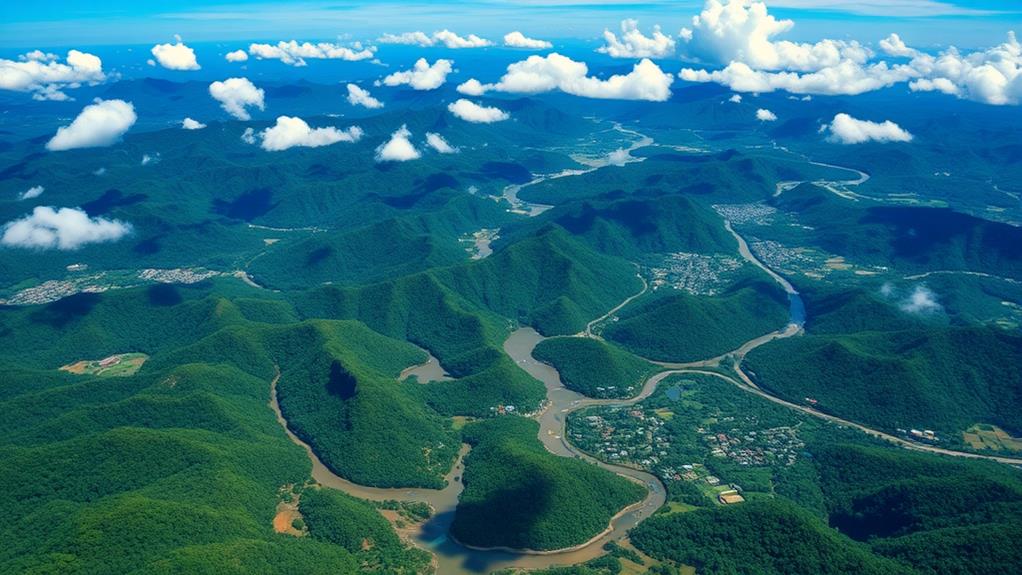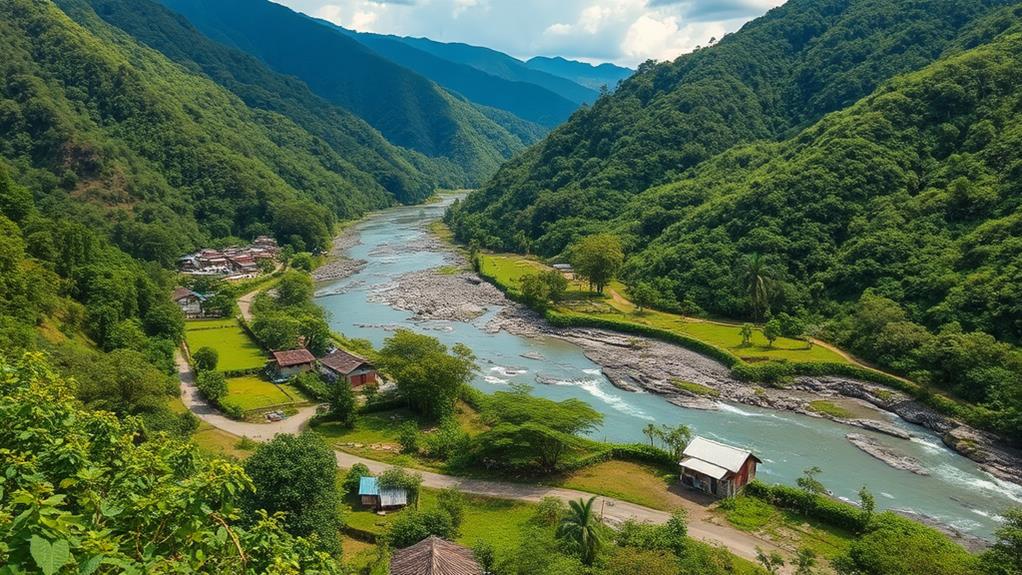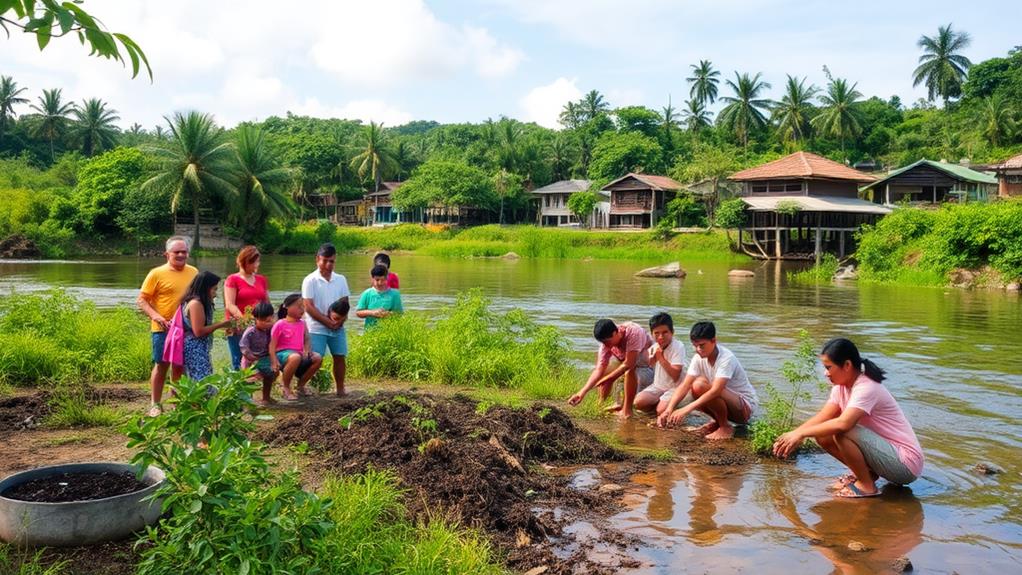Protecting watersheds and water resources in the Philippines is essential for ensuring a reliable water supply and preserving biodiversity. Currently, more than 50% of the country's watersheds lack protection, making them vulnerable to threats like mining and infrastructure projects.
These activities can cause deforestation and soil erosion, which harm both agriculture and community health.
To manage watersheds effectively, strong governance and community participation are necessary. Collaboration between government agencies and NGOs is also important.
For example, local communities can help monitor watershed health and advocate for sustainable practices.
Investments in financial resources and education campaigns are vital to promote sustainable methods. By implementing these strategies, we can create a more resilient environment that benefits both nature and local people.
Current Status of Watersheds

More than 50% of the Philippines' watersheds are unprotected, which is about 7.7 million hectares. This lack of protection threatens both water supply and ecosystem health. Specifically, 6.8 million hectares of these areas are at risk from activities like mining and infrastructure development, which cause deforestation and erosion. This situation calls for urgent action to improve watershed protection and water management.
Only 22% of the land, or 6.5 million hectares, is protected under the National Integrated Protected Areas System (NIPAS). Furthermore, 9% of ecologically critical watersheds have no protection, and 55% of agriculturally important watersheds are also unprotected. This lack of protection affects the essential services that these watersheds provide to nearby communities.
The management of watersheds is complicated by the presence of over 30 government agencies that share responsibilities. This overlap can lead to conflicts and inefficiencies.
Local government units are important in tackling these issues, but they need a clear strategy to effectively protect watersheds. It's crucial to focus on these areas to ensure the sustainability of both natural resources and ecosystems.
Importance of Watershed Protection
Over 50% of the Philippines' watersheds are unprotected, which affects their ability to provide important services. Effective watershed protection is necessary for water supply and sanitation, which are essential for farming and community health. Climate change poses ongoing challenges, making it crucial to understand the following:
- Flood Control: Watersheds manage floods and reduce the impact of severe weather. For example, they can help prevent flooding in both cities and rural areas, protecting homes and farmland.
- Biodiversity Preservation: Healthy watersheds support many types of plants and animals. This diversity is important for keeping ecosystems balanced and helps various wildlife species survive.
- Economic and Social Stability: Protected watersheds help ensure food security. They support irrigation systems that cover about 14.2 million hectares, which helps farmers and indigenous communities thrive.
Working together through watershed management councils can improve protective measures and address the weaknesses of these ecosystems.
Prioritizing watershed protection not only safeguards natural resources but also strengthens community resilience against climate change. The health of watersheds is directly linked to the well-being of the environment and the people who depend on them.
Policy and Governance Issues

The policy and governance issues surrounding watersheds in the Philippines are serious problems that hurt environmental management.
Many existing policies are ineffective, which leads to environmental harm and doesn't protect water resources or local communities.
Overlapping laws and weak enforcement allow harmful activities, like mining and building projects, to use nearly 70% of the country's water resources.
Only 22% of the land in the Philippines is protected under the National Integrated Protected Areas System (NIPAS).
This means that many important watersheds lack legal protection.
For example, the Masungi Georeserve case shows how the lack of environmental assessments for infrastructure projects can lead to increased risks.
To fix these problems, it's essential to create local watershed management councils.
Also, the government should pass national laws that declare watershed reserves as no-go zones for harmful activities.
By improving policies and local governance, the Philippines can better protect its watersheds.
This will help ensure sustainable water resource management for both current and future generations.
Infrastructure Development Impact
Infrastructure development in the Philippines presents serious challenges to the health of watersheds.
Many projects start without proper environmental assessments, which can lead to serious harm to water quality and ecosystems. For example, the Masungi Georeserve case shows how infrastructure can threaten important species and habitats due to weak legal protections.
About 70% of the country's water resources are used by mining and industries. This high level of consumption worsens the negative effects of infrastructure projects on natural resources.
To address these problems, consider these key points:
- Environmental Assessments: Many infrastructure projects don't undergo thorough evaluations. This oversight can cause long-lasting damage to watershed systems, as seen in areas affected by unchecked construction.
- Legal Protections: There are many overlapping laws, but poor enforcement allows harmful projects to move forward in sensitive ecological areas, like forests and wetlands.
- Conservation Efforts: Infrastructure projects often disrupt conservation work, putting additional pressure on fragile ecosystems. For instance, new roads can lead to increased pollution and habitat loss.
To tackle these issues, there needs to be an urgent shift towards development that prioritizes watershed protection.
Integrating environmental considerations into planning processes is essential to ensure that water resources remain sustainable for future generations.
Recommendations for Improvement

Effective watershed management is important for protecting our water resources. Integrating watershed management councils into local planning processes can help improve decision-making about water use and environmental protection.
For example, these councils can work with local governments to create plans that prioritize clean water.
A moratorium on new agribusiness, mining, and infrastructure projects can protect vulnerable watersheds from harm. By designating certain areas as no-go zones, we can keep ecologically sensitive places safe.
This helps ensure that future generations have access to healthy ecosystems and resources.
Advocating for new legislation to close loopholes in watershed regulations is essential. This can strengthen the legal rights of people who rely on clean water.
For instance, stricter laws can prevent pollution from harmful activities.
Allocating public funds to support Indigenous communities in managing watersheds is vital. This investment can lead to sustainable practices that benefit everyone.
Empowering these communities respects their traditional knowledge and helps enhance conservation efforts.
How does Forest Conservation Help in Protecting Watersheds and Water Resources in the Philippines?
The role of forest conservation in the Philippines is crucial in protecting watersheds and water resources. Forests act as natural filters, preventing soil erosion and maintaining water quality. They also help regulate water flow, reducing the risk of flooding and ensuring a steady supply of clean water for communities and ecosystems.
Financial Investments in Watersheds
Investing in watersheds is essential for sustainable water resources and environmental health in the Philippines. In 2023, the government has allocated 676.6 billion pesos (about $12 billion) for watershed funding. This investment can greatly improve water supply and protect ecosystems.
However, it's important that these financial investments are transparent and accountable because detailed budget information is often lacking.
To make the most of these investments, here are some effective strategies:
- Engage the Private Sector: Working with businesses can boost public funding and lead to new restoration projects. For example, a company might help fund reforestation efforts in exchange for community support.
- Promote Sustainable Agriculture: Teaching local farmers to use sustainable practices can help them earn a living while also protecting watershed areas. For instance, using organic farming methods can reduce chemical runoff into water sources.
- Enhance the National Greening Program: Improving the quality of planting materials can lead to better success in restoring ecosystems. For example, using native tree species can make the area more resilient to climate change.
The Local Government Code allows communities to actively manage their watershed resources.
Community Involvement and Engagement

Community involvement is essential for effective watershed management in the Philippines. Local participation improves conservation efforts and ensures that the needs of Indigenous communities are considered in decision-making.
The Philippine government's 2023 budget allocated 676.6 billion pesos for watershed initiatives, highlighting the importance of public investment in community-led restoration and protection efforts.
Successful community-based management shows that sharing knowledge and engaging locals enhances watershed protection. For example, education and awareness campaigns help people understand why protecting their watersheds is important. As a result, communities are more likely to participate in sustainable practices.
Collaborative efforts, such as working with NGOs and local government units, are crucial for mobilizing resources. These partnerships build community skills, allowing residents to take an active role in managing their watersheds sustainably.
Questions and Answers
How Can We Protect Watersheds and the Water in Them?
To protect watersheds, you can take several important actions. First, promote sustainable practices such as using less harmful fertilizers and reducing waste. For example, practicing organic farming helps keep chemicals out of water sources.
Next, encourage community involvement. Organizing local clean-up events can help remove trash from rivers and streams, keeping the water clean.
Support reforestation efforts by planting trees in areas around watersheds. Trees help filter rainwater and prevent soil erosion, which protects water quality.
Implement pollution prevention strategies like proper waste disposal and recycling programs. This reduces the amount of harmful substances that can enter the water supply.
Back education programs in schools and communities. Teaching people about the importance of watersheds can lead to better protection efforts.
How to Conserve and Protect Water Resources in the Philippines?
To conserve water resources in the Philippines, several effective methods can be used. First, implement rainwater harvesting by collecting rainwater from roofs and storing it for later use. This helps reduce reliance on groundwater.
Second, adopt sustainable agriculture practices. For example, using drip irrigation systems can minimize water waste while still providing crops with the water they need.
Third, engage communities in watershed management. Involving local people in protecting watersheds ensures that water sources remain clean and plentiful.
Fourth, it is important to enhance pollution control. This can be done by enforcing regulations to prevent factories from discharging harmful waste into rivers.
Fifth, support reforestation efforts by planting trees in areas where forests have been cut down. Trees help maintain the water cycle and improve water quality.
Finally, promote eco-friendly practices among individuals and businesses. For instance, using biodegradable products reduces pollution and supports healthy ecosystems.
What Are the Problems With the Watershed in the Philippines?
Deforestation and urbanization cause biodiversity loss in the Philippines. For example, when forest areas are cut down for agriculture or city development, many plants and animals lose their homes. Pollution worsens climate change. Factories and waste from cities release harmful substances into rivers and air, leading to problems like global warming. Improper land use harms watershed health. When land is not used correctly, such as over-farming or building on flood zones, it can lead to soil erosion and poor water quality. Community involvement is essential to solve these problems. When local people participate in conservation efforts, they can help protect their environment and restore ecosystems.
What Are the 5 Critical Watersheds in the Philippines?
The five critical watersheds in the Philippines are Pampanga, Cagayan, Agusan, Mindanao, and Bicol. These watersheds are essential for maintaining water supply and supporting local ecosystems. For instance, the Cagayan Watershed is crucial for irrigation and flood control in the region, while the Agusan Watershed supports rich biodiversity, including many unique species. Proper management of these watersheds is important because it helps protect the environment and supports communities in sustainable practices.